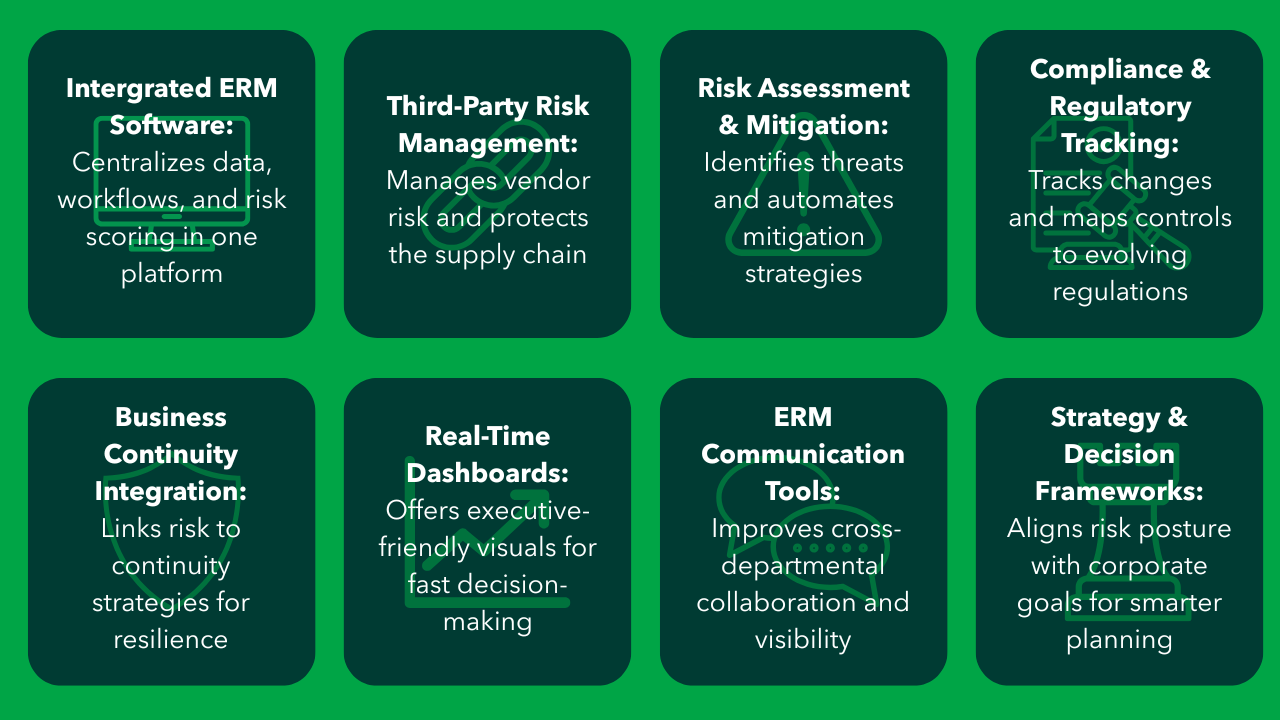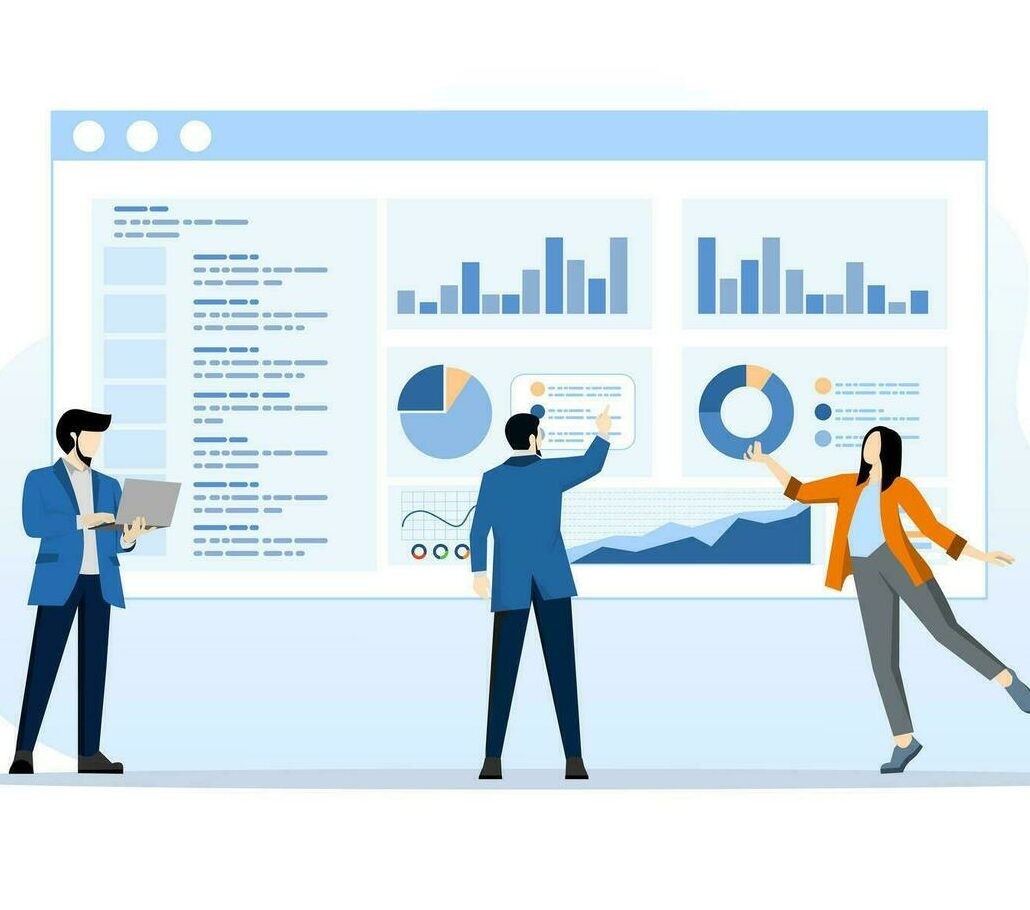In today’s fast-changing risk environment, organizations need more than reactive controls, they need visibility, agility, and strategy. That’s why ERM solutions (Enterprise Risk Management solutions) are now an integral part of smart business operations.
An effective enterprise risk management (ERM) program doesn’t just track risks, it creates a holistic view of your organization’s risk appetite, exposures, and priorities, helping the C-suite and operational leaders make informed decisions across all business units.
If you’re looking to modernize your risk management processes, here are eight high-impact ERM tools and strategies to consider:
1. Integrated ERM Software Platforms
Modern ERM software centralizes the entire ERM program into a single platform unifying data, workflows, and analytics.
Key features include:
- Risk identification and scoring
- Key risk indicators (KRIs) tied to key performance indicators (KPIs)
- Real-time risk monitoring and reporting
- Advanced analytics for forecasting and prioritization
- Integration with existing systems and business processes
These platforms offer a holistic approach to managing risk, eliminating manual processes, and enabling cross-functional decision making.
2. Third-Party Risk Management (TPRM) Tools
With increased outsourcing, third party risks are among the fastest-growing threats. ERM solutions now incorporate third party risk management capabilities to assess, monitor, and mitigate vendor-related vulnerabilities.
Why it matters:
- Protects against supply chain disruptions
- Ensures regulatory compliance and data privacy
- Provides risk insights into critical vendors handling sensitive information
These tools allow businesses to mitigate risks early and ensure that partners support, not weaken, the organization’s business strategy.
3. Risk Assessment & Mitigation Modules
Effective risk management begins with robust risk assessments and targeted mitigation strategies.
ERM software enables teams to:
- Identify potential threats and existing risks
- Evaluate exposure using risk analysis models
- Automate risk mitigation plans tied to the organization’s business goals
These capabilities support a proactive approach to risk, helping organizations stay ahead of disruptions and align mitigation with impact.
4. Compliance & Regulatory Change Tracking
With ever-evolving regulatory requirements, ERM solutions often integrate compliance management features that support both compliance efforts and risk and compliance alignment.
These features include:
- Automatic alerts for regulatory changes
- Mapping regulations to specific controls and business continuity management
- Documenting responses and audit trails
The result is simplified compliance tracking and reduced risk of violations, both of which give your firm a competitive advantage.
5. Business Continuity Planning Integration
ERM solutions are now critical to business continuity and resilience planning. By integrating with business continuity management platforms, organizations can link operational risk to response strategies.
This helps with:
- Responding to risk events in real-time
- Ensuring enterprise wide approach to continuity
- Protecting against reputational damage and financial loss
It ensures risks are managed in the context of maintaining essential business performance.
6. Real-Time Dashboards & Reporting Tools
For enterprise risks to be properly addressed, risk leaders need fast access to actionable data.
ERM solutions deliver:
- Custom dashboards for decision makers
- Reports that align risk data with business models and strategic objectives
- Visual tools for risk exposure heat mapping
This kind of decision support is critical for both operations and the boardroom, especially when navigating crisis moments.
7. ERM Communication Tools
Strong ERM programs depend on cross-department collaboration. Built-in communication tools within ERM platforms improve information flow between departments and break down silos.
This facilitates:
- Shared ownership of risk across the entire organization
- Timely escalation of critical risks
- Greater risk awareness among teams
A collaborative risk culture improves execution and reduces oversights across functions.
8. ERM Strategy Alignment & Decision Frameworks
Lastly, the best enterprise risk management solutions help organizations align risk posture with growth. ERM becomes a tool for strategy, not just protection.
ERM tools allow you to:
- Define and monitor risk appetite thresholds
- Align risk with corporate goals and growth opportunities
- Support business continuity and resilience in long-term planning
This alignment makes ERM a driver of better business performance, not just a safeguard against loss.

Final Thoughts: ERM Solutions Are the Future of Smart Risk
As organizations face mounting complexity and growing risk exposure, leveraging the right ERM solutions is no longer optional. It’s a requirement for making faster, safer, and smarter decisions that support your strategy and protect your future.
Whether you’re adopting ERM software for the first time or enhancing an existing ERM program, prioritize tools that offer flexibility, seamless integration, and a comprehensive view of your risk landscape.
Our experts help organizations design, implement, and optimize ERM frameworks that drive resilience, unlock risk-related information, and improve decision making at every level.
Need help selecting the right ERM solution?Request a Demo



